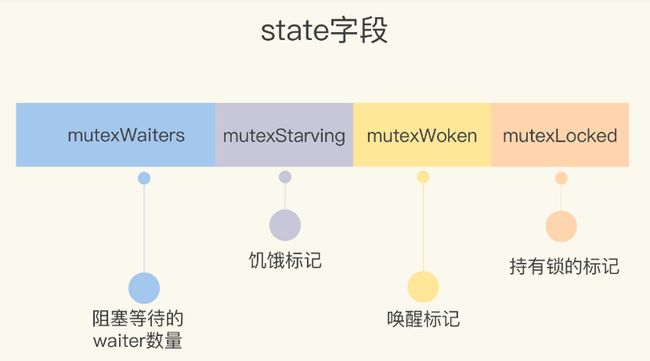互斥锁Mutex
使用锁保护共享资源
Locker()是一个interface。
type Locker interface {
Lock()
Unlock()
}mutex结构体
type Mutex struct {
state int32
sema uint32
}state:
state 是一个复合型的字段,一个字段包含多个意义,这样可以通过尽可能少的内存来实现
互斥锁。这个字段的第一位(最小的一位)来表示这个锁是否被持有,第二位代表是否有
唤醒的 goroutine,第三位代表锁释放处于饥饿状态,剩余的位数代表的是等待此锁的 goroutine 数。
sema:
sema是个信号量变量,用来控制等待 goroutine 的阻塞休眠和唤醒。
Lock()
Mutex 可以处于 2 种操作模式:正常模式和饥饿模式。
在正常模式下,waiters按 FIFO 顺序排队,但是被唤醒的waiters不拥有mutex并与新到达的 goroutines 竞争mutex所有权。新到达的 goroutine 有一个优势——它们是已经在 CPU 上运行并且可能有很多,所以被唤醒waiter可能会失败。在这种情况下,唤醒的waiter会在排在等待队列的前面。如果waiter超过 1ms 未能获取mutex,它将mutex切换到饥饿模式。
在饥饿模式下,mutex的所有权直接从解锁 goroutine 移交给队列前面的waiter。
新到达的 goroutine 不会尝试获取互斥锁,即使它看起来已解锁,也不会尝试自旋。相反,他们将自己排在等待队列的尾部。
如果waiter收到mutex的所有权并看到
(1) 它是队列中的最后一个等待者
(2) 它等待的时间不到 1ms,它将互斥锁切换回正常操作模式。
正常模式具有更好的性能,因为即使有阻塞的waiter,goroutine 可以连续多次获得mutex。
饥饿模式对于防止尾部延迟的病理情况很重要。
func (m *Mutex) Lock() {
// Fast path: grab unlocked mutex.
// cas获取到锁
if atomic.CompareAndSwapInt32(&m.state, 0, mutexLocked) {
if race.Enabled {
race.Acquire(unsafe.Pointer(m))
}
return
}
// Slow path (outlined so that the fast path can be inlined)
// 尝试自旋竞争或饥饿状态下饥饿goroutine竞争
m.lockSlow()
}
func (m *Mutex) lockSlow() {
// 记录此 goroutine 请求锁的初始时间
var waitStartTime int64
// 此goroutine的饥饿标记
starving := false
// 唤醒标记
awoke := false
// 自旋次数
iter := 0
// 当前锁的状态
old := m.state
for {
// Don't spin in starvation mode, ownership is handed off to waiters
// so we won't be able to acquire the mutex anyway.
// 锁是非饥饿状态,锁未释放,自旋尝试获取锁
// 如果无法直接获取锁,进行多次自旋尝试;多次尝试失败,进入sema队列休眠
if old&(mutexLocked|mutexStarving) == mutexLocked && runtime_canSpin(iter) {
// Active spinning makes sense.
// Try to set mutexWoken flag to inform Unlock
// to not wake other blocked goroutines.
// 尝试设置 mutexWoken 标志以通知 Unlock 不要唤醒其他阻塞的 goroutine。
if !awoke && old&mutexWoken == 0 && old>>mutexWaiterShift != 0 &&
atomic.CompareAndSwapInt32(&m.state, old, old|mutexWoken) {
awoke = true
}
runtime_doSpin()
iter++
// 再次获取锁的状态,之后会检查是否锁被释放了
old = m.state
continue
}
new := old
// Don't try to acquire starving mutex, new arriving goroutines must queue.
// 不要尝试获取饥饿的互斥锁,新到达的 goroutine 必须排队。
if old&mutexStarving == 0 {
// 非饥饿状态,加锁
new |= mutexLocked
}
if old&(mutexLocked|mutexStarving) != 0 {
// waiter数量加1
new += 1 << mutexWaiterShift
}
// The current goroutine switches mutex to starvation mode.
// But if the mutex is currently unlocked, don't do the switch.
// Unlock expects that starving mutex has waiters, which will not
// be true in this case.
// 当前的 goroutine 将 mutex 切换到饥饿模式。
if starving && old&mutexLocked != 0 {
// 设置饥饿状态
new |= mutexStarving
}
if awoke {
// The goroutine has been woken from sleep,
// so we need to reset the flag in either case.
// goroutine 已经从睡眠中唤醒,
// 所以我们需要在任何一种情况下重置标志。
if new&mutexWoken == 0 {
throw("sync: inconsistent mutex state")
}
// 新状态清除唤醒标记
new &^= mutexWoken
}
// cas成功设置新状态
if atomic.CompareAndSwapInt32(&m.state, old, new) {
// 原来锁的状态已释放,并且不是饥饿状态,正常请求到了锁,返回
if old&(mutexLocked|mutexStarving) == 0 {
break // locked the mutex with CAS
}
// If we were already waiting before, queue at the front of the queue.
// 如果我们之前已经在等待,请在队列的前面排队。
// 判断是否第一次加入到 waiter 队列
queueLifo := waitStartTime != 0
if waitStartTime == 0 {
waitStartTime = runtime_nanotime()
}
// 阻塞等待
// 将此 waiter 加入到队列,如果是首次,加入到队尾,先进先出。如果不是首次,那么加入到队首,这样等待最久的 goroutine 优先能够获取到锁。此 goroutine 会进行休眠。
runtime_SemacquireMutex(&m.sema, queueLifo, 1)
// 唤醒之后检查锁是否应该处于饥饿状态,此时已经被唤醒
// 检查等待时间是否大于1ms
starving = starving || runtime_nanotime()-waitStartTime > starvationThresholdNs
old = m.state
// 如果锁已经处于饥饿状态,直接抢到锁,返回
if old&mutexStarving != 0 {
// If this goroutine was woken and mutex is in starvation mode,
// ownership was handed off to us but mutex is in somewhat
// inconsistent state: mutexLocked is not set and we are still
// accounted as waiter. Fix that.
if old&(mutexLocked|mutexWoken) != 0 || old>>mutexWaiterShift == 0 {
throw("sync: inconsistent mutex state")
}
// 加锁,waiter数减1
delta := int32(mutexLocked - 1<>mutexWaiterShift == 1 {
// Exit starvation mode.
// Critical to do it here and consider wait time.
// Starvation mode is so inefficient, that two goroutines
// can go lock-step infinitely once they switch mutex
// to starvation mode.
// 退出饥饿模式。
// 此 waiter 已经是队列中的最后一个 waiter 了,没有其它的等待锁的 goroutine 了;
// 此 waiter 的等待时间小于 1 毫秒。
delta -= mutexStarving
}
atomic.AddInt32(&m.state, delta)
break
}
awoke = true
iter = 0
} else {
old = m.state
}
}
if race.Enabled {
race.Acquire(unsafe.Pointer(m))
}
}
Unlock()
func (m *Mutex) Unlock() {
if race.Enabled {
_ = m.state
race.Release(unsafe.Pointer(m))
}
// Fast path: drop lock bit.
new := atomic.AddInt32(&m.state, -mutexLocked)
if new != 0 {
// Outlined slow path to allow inlining the fast path.
// To hide unlockSlow during tracing we skip one extra frame when tracing GoUnblock.
m.unlockSlow(new)
}
}
func (m *Mutex) unlockSlow(new int32) {
if (new+mutexLocked)&mutexLocked == 0 {
fatal("sync: unlock of unlocked mutex")
}
if new&mutexStarving == 0 {
old := new
for {
// If there are no waiters or a goroutine has already
// been woken or grabbed the lock, no need to wake anyone.
// In starvation mode ownership is directly handed off from unlocking
// goroutine to the next waiter. We are not part of this chain,
// since we did not observe mutexStarving when we unlocked the mutex above.
// So get off the way.
// 如果 Mutex 处于正常状态,如果没有 waiter,或者已经有在处理的情况了,那么释放就好,不做额外的处理。
if old>>mutexWaiterShift == 0 || old&(mutexLocked|mutexWoken|mutexStarving) != 0 {
return
}
// Grab the right to wake someone.
// waiter 数减 1,设置mutexWoken 标志,通过 CAS 更新 state 的值。
new = (old - 1<TryLock()
当一个 goroutine 调用这个TryLock 方法请求锁的时候,如果这把锁没有被其他 goroutine 所持有,那么,这个goroutine 就持有了这把锁,并返回 true;如果这把锁已经被其他 goroutine 所持有,或者是正在准备交给某个被唤醒的 goroutine,那么,这个请求锁的 goroutine 就直接返回
false,不会阻塞在方法调用上。
func (m *Mutex) TryLock() bool {
old := m.state
if old&(mutexLocked|mutexStarving) != 0 {
return false
}
// There may be a goroutine waiting for the mutex, but we are
// running now and can try to grab the mutex before that
// goroutine wakes up.
if !atomic.CompareAndSwapInt32(&m.state, old, old|mutexLocked) {
return false
}
if race.Enabled {
race.Acquire(unsafe.Pointer(m))
}
return true
}